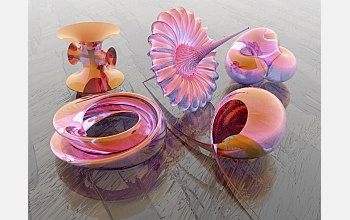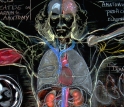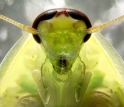News Release 06-133
2006 Science and Engineering Visualization Challenge Winners Announced
Winning entries appear in this week's Science magazine

"Still Life: Five Glass Surfaces on a Tabletop"
September 22, 2006
This material is available primarily for archival purposes. Telephone numbers or other contact information may be out of date; please see current contact information at media contacts.
Sometimes the best way to express a scientific idea is through an image that grabs the eye and invites viewers to wonder what they're seeing.
Fourteen images and multimedia presentations, each using innovative approaches to encapsulate a scientific story, have won the 2006 Science and Engineering Visualization Challenge, a competition sponsored jointly by the National Science Foundation and the journal Science, which is published by the American Association for the Advancement of Science.
Currently in its fourth year, the contest recognizes outstanding achievement in the use of visual media to promote understanding of research results and scientific phenomena. The judges' criteria for evaluating the entries included visual impact, innovation and accuracy, among others.
Winning entries communicate information about complex mathematical concepts, the intricacies of the human body, air-flight patterns, the latest scientific imaging technologies to analyze Leonardo da Vinci's art, and more. The Sept. 22, 2006 issue of Science features all the entries, which will also be freely available at www.sciencemag.org/sciext/vis2006/show/. The entries are also displayed at the National Science Foundation's Web site, http://nsf.gov/news/special_reports/scivis/index.jsp?id=win2006.
The winning entries are in five categories:
ILLUSTRATION
First Place:
Richard Palais, University of California, Irvine
Luc Benard
Still Life: Five Glass Surfaces on a Tabletop
Second Place:
Caryn Babaian, Bucks County Community College, Newtown, Penn.
A Da Vinci Blackboard Lesson
INFORMATIONAL GRAPHICS
First Place:
Nils Sparwasser, Thorsten Andresen, Stephan Reiniger, and Robert Meisner, German Aerospace Center
Hawaii, the Highest Mountain on Earth
Second Place:
Louis Borgeat, François Blais, and John Taylor of the National Research Council, Canada
Christian Lahanier of the Centre de recherche et de restauration des musées de France
Mona Lisa Montage
PHOTOGRAPHY
First Place:
Robert Cheng, Paul Brown, and Rebecca Fahrig, Stanford University
Christof Reinhart, Volume Graphics
An Egyptian Child Mummy
Second Place:
David Yager, University of Maryland
Cockroach Portrait
INTERACTIVE MULTIMEDIA
First Place:
Travis Vermilye, Stephen Humphries, and Andrew Christensen, Medical Modeling, Golden, Colorado
Kenneth Slayer, International Craniofacial Institute, Dallas, Texas
Conjoined Twins
Second Place:
Jack Bradbury, Guillaume Iacino, Erica Olsen, and Robert Grotke, Cornell Lab of Ornithology, Cornell University
A Real-Time Audio and Video Sound Visualization Tool
NONINTERACTIVE MULTIMEDIA
First Place(tie):
Aaron Koblin, University of California, Los Angeles
Flight Patterns
Drew Berry and Francois Tetaz, The Walter and Eliza Hall Institute, Melbourne, Australia; Jeremy Pickett-Heaps, University of Melbourne
Body Code
Honorable Mentions:
Curtis DuBois, Lummi Island, Washington
The Handwritten "e"
Matt Heying, Changwon Suh, and Krishna Rajan, Iowa State University
Simone Seig, Universität de Saarland
Materials Informatics
Jennifer Brennan, ADNET Systems Inc./NASA Goddard Space Flight Center; Waleed Abdalati,
Horace Mitchell, NASA Goddard Space Flight Center; and Walter Meier, National Snow and Ice Data Center
A Short Tour of the Cryosphere
Flavio Fenton and Elizabeth Cherry, Cornell University
Cardiac Bioelectricity and Arrhythmias
Further information about the 2006 Science and Engineering Visualization Challenge is available at http://www.nsf.gov/news/special_reports/scivis/index.jsp.
Reporters may request copies of the Science feature, which describes the winning entries, from the AAAS Office of Public Programs, at +1-202-326-6440 (phone) +1-202-789-0455 (fax) or scipak@aaas.org (email).
The American Association for the Advancement of Science (AAAS) is the world's largest general scientific society, and publisher of the journal Science (www.sciencemag.org). The nonprofit AAAS (www.aaas.org) is open to all and fulfills its mission to "advance science and serve society" through initiatives in science policy; international programs; science education; and more. For the latest research news, log onto EurekAlert!, www.eurekalert.org, a service of AAAS.
-NSF-
-
"A DaVinci Blackboard Lesson in Multi-Conceptual Anatomy"
Credit and Larger Version -
"Cockroach Portrait"
Credit and Larger Version
Media Contacts
Natasha Pinol, AAAS, (202) 326-7088, email: npinol@aaas.org
Program Contacts
Susan M. Mason, NSF, (703) 292-7748, email: smason@nsf.gov
Related Websites
Science and Engineering Visualization Challenge Info: http://www.nsf.gov/news/special_reports/scivis/index.jsp
The U.S. National Science Foundation propels the nation forward by advancing fundamental research in all fields of science and engineering. NSF supports research and people by providing facilities, instruments and funding to support their ingenuity and sustain the U.S. as a global leader in research and innovation. With a fiscal year 2023 budget of $9.5 billion, NSF funds reach all 50 states through grants to nearly 2,000 colleges, universities and institutions. Each year, NSF receives more than 40,000 competitive proposals and makes about 11,000 new awards. Those awards include support for cooperative research with industry, Arctic and Antarctic research and operations, and U.S. participation in international scientific efforts.
Connect with us online
NSF website: nsf.gov
NSF News: nsf.gov/news
For News Media: nsf.gov/news/newsroom
Statistics: nsf.gov/statistics/
Awards database: nsf.gov/awardsearch/
Follow us on social
Twitter: twitter.com/NSF
Facebook: facebook.com/US.NSF
Instagram: instagram.com/nsfgov




